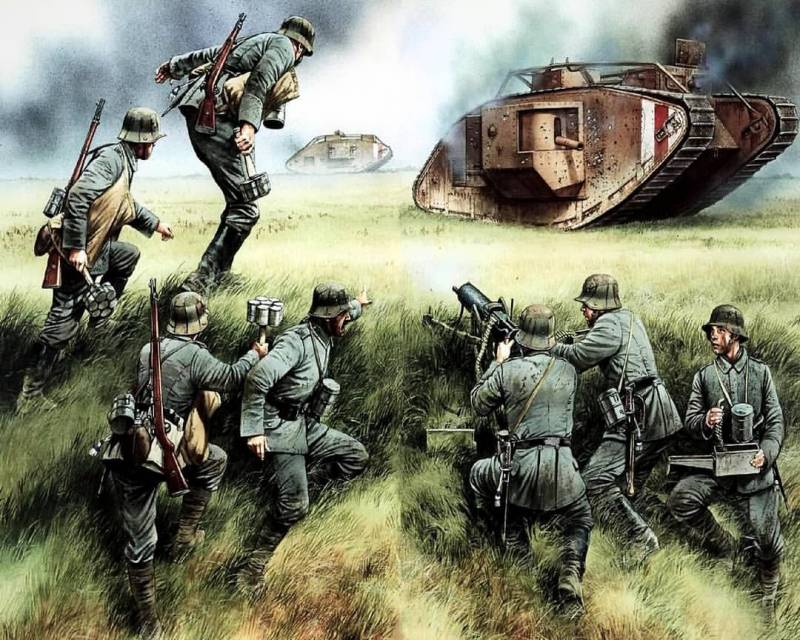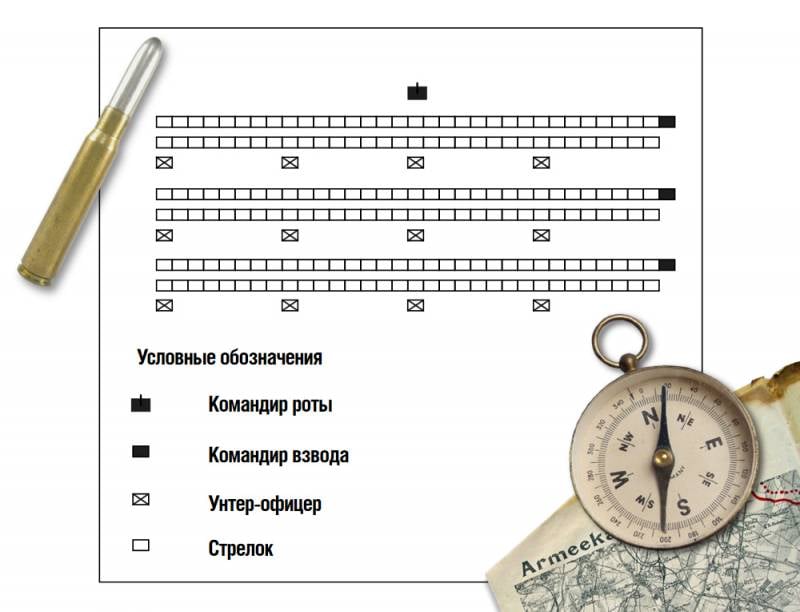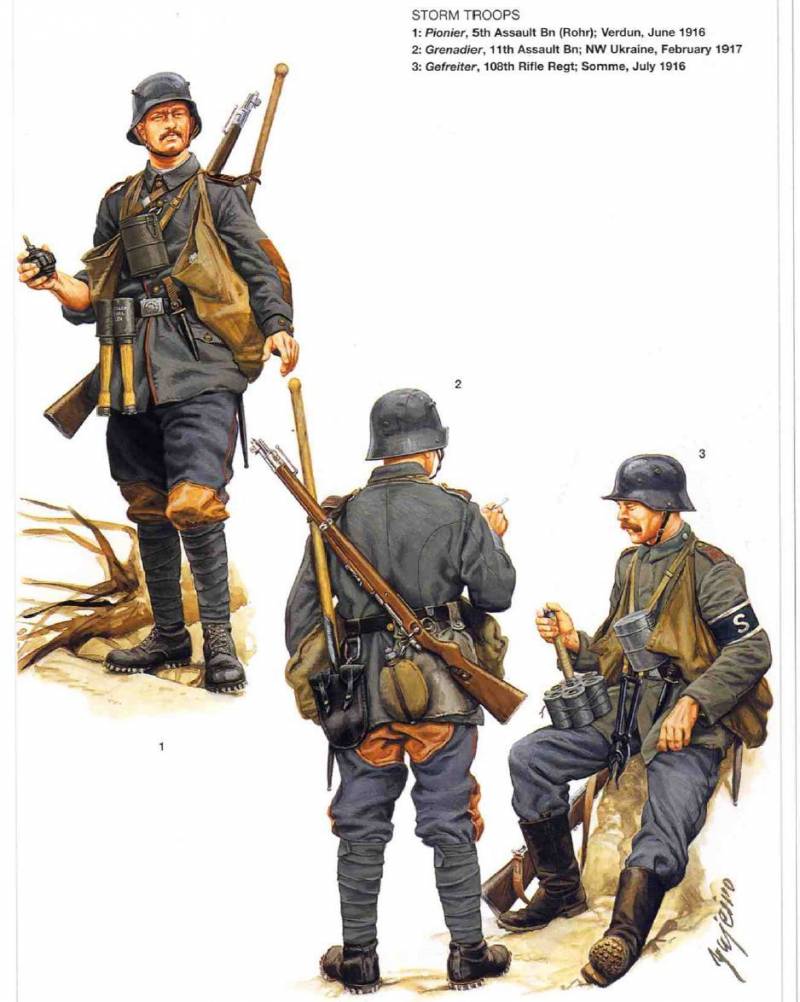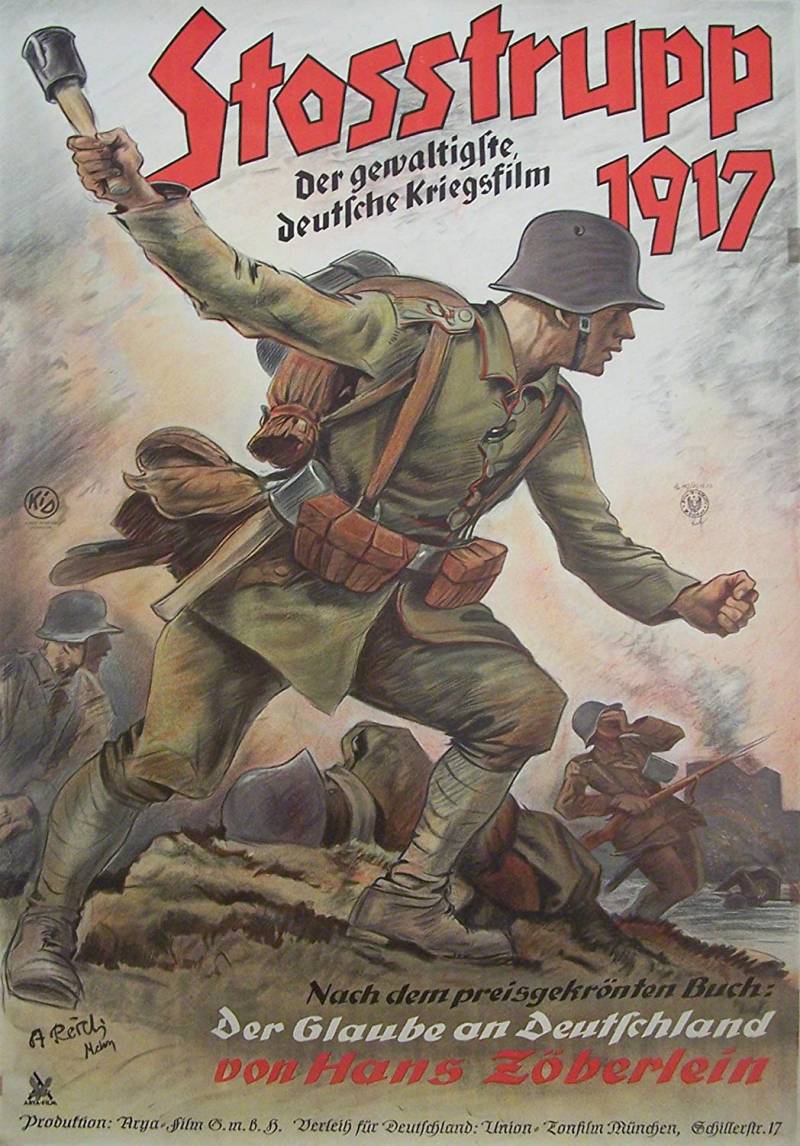Assault groups of the Second Reich
Birth marks of the past
In terms of infantry tactics, the German army 1914 of the year largely remained the product of a past era. The philosophy of the 1870-71 victorious Franco-Prussian war prevailed - the dense ranks of soldiers under the supervision of non-commissioned officers move forward, keeping the line for the "Teutonic rage" - a strong bayonet attack that decides the outcome of the battle.
The state factor also preserved this situation - the army, as a social institution, paid the closest attention to the origin of the candidate officer. The traditional officer caste sought to preserve itself, so the pre-war army was more likely to tolerate a shortage of junior commanding staff, rather than to take on "any people." As a result, a single lieutenant was forced to command an infantry platoon in 80 people.
Of course, he had non-commissioned officers. But they also performed the duties prescribed by the "aristocratic" vision. "Unther" should not have led the soldiers to attack, command - on the contrary, they went behind the lines deployed to attack. All in order to catch and return to the deserters. All according to the canons of the attitude towards the soldier, as a peasant recruit, and not a citizen from the era of developed cities and political nations.
All this once again pushed the German army to the tactics of dense bayonet attacks - so all the soldiers would be “under supervision”. The building, designed to keep the bulk from desertion, extended to the very best, the imperial guard. Moreover, it was the subject of their pride, a tradition passed down through soldiers' generations. But, when this valiant tradition interbred with a big industrial war, with the world of machine guns, artillery and magazine rifles, the result was sad.
Take, for example, the well-known attack of the 2 Guards Infantry Division near Ypres in November 1914. Dashing guardsmen bravely went under the bullets in close ranks. There were so many of them that, even despite the terrible fire, the Germans managed to seize the first trench of the enemy. But only by that time there were so few of them that the enemy repulsed the trenches with the very first counterattack.
Need to do something
Similar stories in the first year of the war, not only guardsmen took place. It became clear to the Germans - it is necessary to move away from the dense system. As with a bayonet attack - in zigzag trenches with a bayonet, in any case, you will not turn around. Fortunately for them, there was a reserve for this - its roots lay in the federal structure of the German Empire.
Germanic lands, throughout its history, were still a patchwork quilt. Participating in the First World War, the Second Reich gathered from this blanket not so long ago - less than half a century before the war. The result was the autonomy of some lands (for example, Bavaria) and a rather decentralized army structure. For example, in peacetime, each regiment was fairly autonomous, and its commander had rather broad powers and serious freedom in the training of his soldiers. And he could practice even a loose build, even dense bayonet attacks. Many, of course, chose the latter by inertia. But the wedge did not converge on them.
But by itself, loose operation only slightly reduced losses. This was only the beginning, but the important thing was that the huge losses from the “old-fashioned, aristocratic” tactics made the officers trust the soldiers more. Now it was not supposed that the fighters, just that, would automatically run away. And non-commissioned officers, along with the most determined soldiers, it became possible to use for something more than just search and hold panties.
One of the first innovators was Captain Wilhelm Rohr. He guessed to give the right to direct command on the battlefield of the most decisive and brave fighters. This made it possible to divide huge sluggish platoons into small groups of 3-10 people. Each of them was assigned a tactical task.
The philosophy of the assault groups was, at first glance, paradoxical. Instead of the concentration of forces prescribed by the basics of military affairs, they were crushed. But this is exactly what allowed us to overcome the “no man’s land” as quickly as possible.
Moreover, a large compound moved predictably even in a loose system. It had a clearly readable front, flanks, and so on. As a large group of people, it would not move very fast. According to it, it was possible to concentrate the fire of the whole unit defending the trench, including means of reinforcement such as heavy machine guns. And in the case of a large number of small groups, in parallel, without communication with each other, breaking through to their specific goals, everything took a different turn. It is almost impossible to give equal attention to all of them at once from the point of view of conscious fire control.
And if such groups act fairly quickly and decisively, they have a good chance of a successful attack with small losses. After all, an adversary driven "in the old way", the share of personal initiative which is inevitably smaller, simply does not have time to undertake something sensible.
Miracle weapon
The assault battalion of Rohr was actively training - in the rear a model of a specific position was under construction that was to be attacked, and the actions were worked out to the smallest detail. The first serious test of these workouts, and indeed, the new tactics, took place on January 1916, the French position was occupied quickly and with minimal losses.
The following month, the battle for Verdun began. By this time, the success of Rohr managed to impress and other parts. His tactics were imitated by other battalions, where their own assault units were created. And in September, 1916, the glory of the stormtroopers reached General Ludendorff himself.
He understood that the war had gone somewhere wrong - quick victory according to Schlieffen’s plan did not work. In the long standoff at the Central Powers there was no chance - the potentials are painfully unequal. It only remained to look for some kind of "miracle weapon" that would change the balance of power. And the new assault tactics seemed quite promising option.
The rate of retraining of the army under the "assault" standards grew. If by the beginning of the 1917, it was about the 15 assault battalions, then by the next year the Germans began to put into operation entire shock divisions. In the future, it was planned that the "assault" will be a whole quarter of the German army. In these units will gather the youngest, hot, enthusiastic and willing to change the course of war soldiers. And, trained in accordance with the new strike tactics, they will finally break through the frozen front and will transfer the war back to a maneuverable channel.
Something went wrong
By March 1918, the German rear was on its last legs, and the command was well aware of that. The last chance, if not for victory, then at least for a draw in the war, was a successful offensive. The bet in it was placed, just on the attack aircraft.
The task was not easy - to break through the 8-kilometer thick enemy defenses. Impossible at first glance. But the stormtroopers coped. However, the main problems began later.
The attacking Germans made a breach 80 kilometers wide. Had it happened 20 years later, they would have been sent to it right there Tanks, motorized infantry divisions supported by the Stucks. And also a horde of auxiliary equipment, from briskly carrying heavy guns of 18-ton tractors to trucks with ammunition and fuel.
But it was 1918 a year, and the creation of a blitzkrieg infrastructure in Germany was still far away. Designed for violent, but short tension forces, built on the patterns of assault battalions, the division quickly exhausted. They could not move forward with the speed of the maneuver units of the Second World War, and the enemy managed to build a new line of defense, albeit not so strong. But the attack aircraft were already far from "fresh." 6 days they tried unsuccessfully to break through and her, but without visible result.
The offensive failed. The war was actually lost. Assault battalions had a serious impact on the development of infantry tactics, but did not save Germany. Humiliated by the Versailles Treaty, but not crushed, she will return in 20 years. Replacing the methods of Rohr attack aircraft for something even more breakthrough.




Information